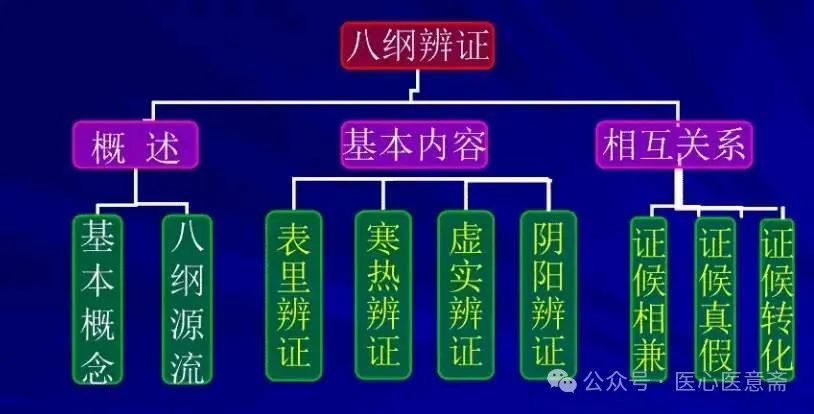Traditional Chinese Medicine (TCM), as a treasure of the Chinese nation, has a long history and profound depth. Within the theoretical system of TCM, the Eight Principles of Diagnosis (Bā Gāng Biànzhèng) occupies an extremely important position, serving as one of the foundational methods and core theories for diagnosing diseases in TCM.

The formation of the Eight Principles of Diagnosis was not achieved overnight; it has a long historical development process. Its ideological origins can be traced back to the Huangdi Neijing (Yellow Emperor’s Inner Canon), a classic TCM text that already contains the embryonic forms of concepts such as Yin and Yang (阴阳), Exterior and Interior (表里), Cold and Heat (寒热), and Deficiency and Excess (虚实), laying the theoretical foundation for the establishment of the Eight Principles of Diagnosis. For instance, in the Suwen: On the Correspondence of Yin and Yang (素问·阴阳应象大论), it is mentioned that “Yin and Yang are the principles of heaven and earth, the framework of all things, the parents of change, the origin of life and death, and the abode of the spirit,” emphasizing the importance of Yin and Yang in understanding the natural world and the physiological and pathological changes in the human body.
During the Eastern Han Dynasty, the medical sage Zhang Zhongjing (张仲景) wrote the Shanghan Zabing Lun (Treatise on Cold Damage and Miscellaneous Diseases), closely integrating the theory of the Eight Principles of Diagnosis with clinical practice. Through in-depth studies of cold damage diseases and miscellaneous diseases, he elaborated on the manifestations of different syndromes in terms of Exterior and Interior, Cold and Heat, and Deficiency and Excess, along with corresponding treatment methods, providing a model for later physicians to use the Eight Principles of Diagnosis in treating diseases. For example, when diagnosing external pathogenic diseases, the invasion of pathogens into the body is classified into different stages such as Taiyang Disease (太阳病) (Exterior syndrome) and Yangming Disease (阳明病) (Interior syndrome), and then based on the patient’s specific symptoms, the cold, heat, deficiency, and excess attributes are determined to formulate precise treatment plans.
By the Ming and Qing Dynasties, the theory of the Eight Principles of Diagnosis further developed and improved. The Ming Dynasty physician Zhang Jingyue (张景岳) systematically discussed Yin and Yang, Exterior and Interior, Cold and Heat, and Deficiency and Excess in his work Jingyue Quanshu (Complete Works of Jingyue), proposing specialized discussions such as “Yin and Yang Chapter” and “Six Transformations Diagnosis,” emphasizing that Yin and Yang is the overarching principle of the Eight Principles, with the other six principles being subordinate to it, thus making the theoretical system of the Eight Principles of Diagnosis clearer and more structured. The Qing Dynasty physician Cheng Zhongling (程钟龄) formally proposed the term “Eight Principles” and comprehensively summarized the concept, content, and application of the Eight Principles of Diagnosis, making it a complete and mature diagnostic system in TCM.
The Eight Principles of Diagnosis holds extremely important significance for clinical practice in TCM. It provides a clear thought process and method for diagnosing diseases. Faced with complex and diverse clinical symptoms, physicians can quickly grasp the essence and key of the disease using the Eight Principles of Diagnosis, categorizing the intricate conditions into the eight aspects of Yin and Yang, Exterior and Interior, Cold and Heat, and Deficiency and Excess, thereby accurately determining the location, nature, and comparative relationship of pathogenic and righteous forces in the disease. For example, when a patient presents with symptoms such as fever, chills, headache, and a floating pulse, the physician can diagnose it as an Exterior syndrome; if the patient also exhibits thirst, dry throat, and a yellow tongue coating, it can be further identified as an Exterior Heat syndrome. This clear diagnostic thought process aids physicians in formulating targeted treatment principles and methods, improving clinical efficacy.
The Eight Principles of Diagnosis also provides important evidence for the selection of herbal formulas in TCM. TCM emphasizes “treatment based on syndrome differentiation,” meaning that the choice of corresponding formulas and herbs for treatment is based on the results of syndrome differentiation. Different syndromes of the Eight Principles correspond to different treatment principles, such as Exterior syndrome should be treated with exterior-releasing methods, Interior syndrome should be treated internally; Cold syndrome should be warmed, Heat syndrome should be cleared; Deficiency syndrome should be tonified, Excess syndrome should be drained. Based on the results of the Eight Principles of Diagnosis, physicians can accurately select appropriate formulas and herbs, ensuring that the properties and effects of the herbs align with the nature and location of the disease, achieving the goal of “matching herbs with syndromes,” thereby enhancing the therapeutic effects of the herbs and promoting patient recovery.
The Eight Principles of Diagnosis has had a profound impact on the development of TCM. It has become a universal diagnostic method across various clinical specialties in TCM, whether in internal medicine, surgery, gynecology, pediatrics, or otorhinolaryngology, all rely on the guidance of the Eight Principles of Diagnosis. Each clinical department, based on the application of the Eight Principles of Diagnosis, has further developed more specific and detailed diagnostic methods that align with the characteristics of their respective diseases, but the Eight Principles of Diagnosis remains the core and foundation of these diagnostic methods.
The Eight Principles of Diagnosis has also facilitated the inheritance and development of TCM theory. As an important component of TCM theory, it has been widely studied and applied by physicians throughout history, continuously enriched and perfected in practice. Through the study and application of the Eight Principles of Diagnosis, later generations of physicians have gained a deeper understanding of TCM theory, constantly summarizing new experiences and theories, promoting the continuous innovation and development of TCM theory. Furthermore, the Eight Principles of Diagnosis plays an important role in TCM education, serving as foundational content for TCM students in learning TCM diagnostics and clinical courses, helping students establish TCM clinical thinking and laying a solid foundation for cultivating qualified TCM professionals.
As an important method for diagnosing diseases in TCM, the Eight Principles of Diagnosis has a long history, significant meaning, and far-reaching influence. It is not only the cornerstone of TCM clinical practice but also a treasure of the TCM theoretical system, making an indelible contribution to the inheritance and development of TCM, and continues to play an important role in modern TCM clinical practice and research, deserving of our in-depth study and promotion.
The methods of the Eight Principles of Diagnosis mainly include the following:Distinguishing Yin and YangYin syndrome (阴证): This syndrome is characterized by a deficiency of Yang Qi in the body, with an excess of Yin, often manifesting as a pale or dull complexion, lethargy, a heavy body, cold limbs, fatigue, low voice, poor appetite, loose stools, clear and frequent urination, a pale and swollen tongue, white and slippery coating, and a deep, slow, weak, or thin pulse.Yang syndrome (阳证): This refers to a syndrome characterized by an excess of Yang Qi in the body, with damage to Yin fluids, or caused by external pathogenic heat, commonly presenting with a red complexion, fever, hot skin, restlessness, loud voice, wheezing with phlegm, thirst, constipation, short and red urination, a red tongue, yellow or black coating with prickles, and a rapid, strong, slippery pulse. Distinguishing Exterior and InteriorExterior syndrome (表证): This is a type of syndrome where the disease is located superficially in the muscle layer, often seen in the early stages of external pathogenic diseases, primarily characterized by fever, chills (or aversion to wind), body aches, nasal congestion, runny nose, and cough, generally with an acute onset and short duration, thin white coating, and floating pulse.Interior syndrome (里证): This refers to syndromes where the pathological changes occur in the internal organs, Qi, and blood, often resulting from unresolved exterior pathogens penetrating inward. It can manifest in various ways, such as high fever, thirst, abdominal pain, constipation or diarrhea, palpitations, and insomnia, typically with more severe conditions and longer duration, generally without chills, and the pulse is not floating. Distinguishing Cold and HeatCold syndrome (寒证): This syndrome is characterized by the invasion of cold pathogens or Yang deficiency with an excess of Yin. It can be divided into Excess Cold (实寒) and Deficiency Cold (虚寒). Common symptoms include aversion to cold or chills, preference for warmth, lack of thirst, pale complexion, cold limbs, clear and frequent urination, loose stools, pale tongue with white coating, and a slow or tight pulse.Heat syndrome (热证): This syndrome is characterized by the invasion of heat pathogens or an excess of Yang with a deficiency of Yin, often presenting with fever, aversion to heat and preference for cold, thirst, red face and eyes, restlessness, yellow and thick phlegm or nasal discharge, short yellow urination, and dry stools, with a red tongue and yellow coating, and a rapid pulse.Distinguishing Deficiency and ExcessDeficiency syndrome (虚证): This syndrome is characterized by insufficient righteous Qi in the body, often due to congenital deficiencies or inadequate nourishment. It can be categorized into Qi Deficiency (气虚), Blood Deficiency (血虚), Yin Deficiency (阴虚), and Yang Deficiency (阳虚), commonly presenting with fatigue, pale complexion, palpitations, shortness of breath, spontaneous sweating, night sweats, loose stools, and incontinence, with a pale and swollen tongue and weak pulse.Excess syndrome (实证): This syndrome is characterized by the invasion of external pathogens or the accumulation of pathological products within the body. Symptoms may include fever, abdominal distension and pain, chest tightness and restlessness, even confusion and delirium, coarse breathing, phlegm accumulation, constipation, and difficulty urinating, with a strong pulse and thick greasy tongue coating.In clinical applications, the Eight Principles of Diagnosis are often interrelated and intertwined, requiring comprehensive analysis to accurately assess the condition and provide a basis for treatment.

